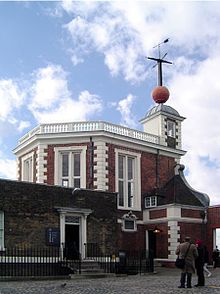Time ball
A time ball was a signal ball attached to an elevated position and visible from afar, which was dropped at a specified time and allowed seafarers to check their ship's chronometers . Exact knowledge of the time was essential in the 19th century in order to precisely determine the longitude of a ship's position at sea. It was therefore important to be able to set the chronometer in the harbor to the second . For this purpose, an optical signal was more suitable than an acoustic signal, such as B. a warning tone.
Time balls were connected to observatories and were mostly triggered electrically. The trigger time at the Royal Greenwich Observatory was 1 a.m. The ball was usually raised halfway five minutes beforehand and pulled all the way up two or three minutes before it fell.
history
The British captain Robert Wauchope (1788-1862) had submitted the proposal for the establishment of time balls at the Admiralty in 1824. From 1829 the first time ball was tested in Portsmouth . In 1833 others followed in Greenwich and on St. Helena , in 1836 in Cape Town (see Signal Hill ). In 1874 , Cuxhaven was the first German port to receive a time ball. This was followed Wilhelmshaven , Bremerhaven , Bremen , Hamburg , Kiel , Swinoujscie and Neufahrwasser in Gdansk .
There were about 160 time balls worldwide, of which about 60 still exist. Most of them were demolished in the 1920s after their task had been taken over by time signal transmitters (Germany 1910, Great Britain 1924) from 1907 .
Trivia
In New York on New Year's Eve 1907, the Times Square Ball was installed on the One Times Square skyscraper , and since then it has been lowered with a countdown on a flagpole one minute before the turn of the year. This traditional ball drop ceremony is one of the highlights of the US New Year celebrations and is now broadcast worldwide. It is based on the idea of the time ball.
Web links
- Meyers Konversationslexikon , Leipzig and Vienna, 4th edition, 1885–1892
- Time balls on historical postcards
